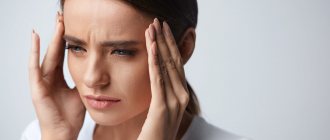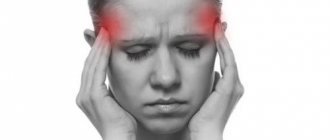Author:
Amelicheva Alena Aleksandrovna medical editor
Headache is one of the most common types of pain. It can be primary, i.e. not associated with any disease, and secondary, caused by disease or injury.
Headache may be accompanied by weakness, dizziness, increased fatigue, nausea, vomiting, fever, blurred vision, changes in blood pressure, appetite and sleep disturbances, muscle weakness, impaired coordination, speech, irritability, aggression, convulsions, loss of consciousness.
Types of headaches
Tension headache (TTH) is the most common type of headache. Its manifestation is most often associated with a person’s psychological state (stress, depression, anxiety) or physiological stress. TTH can occur due to work stress, lack of sleep, skipping meals, or excessive alcohol consumption. The frequency and duration of attacks (mild and moderate intensity) vary from person to person and can vary from person to person. TTH is characterized by a feeling of pressure in the eyes, bilateral compression in the occipital or frontal area, spreading to the entire head and neck. Typically, a person experiencing an attack of tension-type headache will complain that the head feels like it is being “wrapped in a hoop” or “squeezed in a vice.” Tension headache can be either episodic or chronic (per month, the frequency of attacks exceeds the number of days without headache).
Migraines are characterized by repeated attacks of moderate to high intensity throbbing pain (most often on one side of the head), which can last from 3-4 hours to several days. Most often, a migraine attack occurs spontaneously in the morning (after waking up), sometimes it develops “predictably” (for example, before menstruation or on weekends, after a busy work week). The condition may be accompanied by weakness, nausea, vomiting, sensitivity to light and sound, and pain may increase with movement, coughing, or sneezing. It is believed that migraine is caused by genetic causes, i.e. the predisposition to it is congenital (most people with migraine have close relatives with the same diagnosis). Women suffer from migraines several times more often than men.
Factors that contribute to the occurrence of migraines include: extreme fatigue, lack of sleep or, on the contrary, excessive sleep at night, stress, anxiety, hormonal changes in women (associated with pregnancy, menstruation, menopause), bright lights, flashing lights, loud noises, strong odors, sudden changes in weather or environmental conditions, vigorous exercise, smoking, irregular diet, excess coffee consumption, frequent use of migraine medications, certain foods, especially in combination with other triggers (chocolate, cheese, fruits, nuts, pickled foods, dried meats, sausages, yeast).
There are 4 phases of migraine:
- prodrome - the phase of migraine precursors, may be accompanied by inexplicable mood swings, high cravings for certain foods, euphoria, depression, neck stiffness, drowsiness;
- an aura (before a migraine attack or during its process) may be accompanied by “visual effects” - the appearance of blind spots, bright flashes of light, zigzag lines before the eyes, a person may feel muscle weakness, pay attention to impaired hearing, sensitivity;
- headache phase;
- the final phase - postdrome - lasts several hours (or days, like the prodrome), accompanied by weakness, fatigue, depression, and a feeling of emptiness.
The causes of cluster headaches are not exactly known; it is believed that a certain role in this process is played by the pathological activity of the hypothalamus, which regulates body temperature, blood pressure, the functioning of the endocrine system, as well as a sudden increased production of the immediate mediator of allergic reactions such as histamine or the neurotransmitter serotonin. This type of pain occurs less frequently than the above and is more typical for men. It is usually sudden, intense, unilateral, localized in the eye area, lasts from 30 to 90 minutes or longer, can occur every day (or several times a day) and last up to six weeks or more. This long period, in which cycles of headache attacks are followed by periods without headaches, is called a cluster period. Cluster headaches may be accompanied by watery eyes, red eyes, nasal congestion, and runny nose. It can be provoked by alcohol abuse, physical or psycho-emotional stress, and certain medications. Episodic cluster headaches, which occur regularly, lasting from one week to a year with remissions of at least one month, are more common. Chronic cluster pain occurs less frequently, lasts for one year or more, and remission lasts less than 1 month.
Binge drinking - its dangers and consequences
At the first stage of addiction, a person realizes that drinking is bad and understands that alcohol causes absenteeism at work and quarrels with loved ones. However, alcoholics tend to justify their addiction, so every time they look for a reason to drink, even if there is no holiday, the addict will come up with a reason to drink alcohol again, as he develops an irresistible craving.
However, for alcohol addicts, drinking alcohol is not limited to one or two glasses. Binge drinking characterizes the presence of a person in the second stage of addiction. Alcoholics drink for several days in a row, but they can still stop drinking on their own. However, interruption of a false binge, as a rule, is due to some external factors: the person has to go to work, his wife is scandalous, he has run out of money for booze.
However, a disease such as alcoholism tends to progress; soon a person loses control over both the quantity and quality of what he drinks, binge drinking develops into true, and addiction into chronic. A person no longer needs company to drink; he can drink at any time and anywhere, including at work, disregarding generally accepted social boundaries and norms of morality and behavior. Over time, the addict loses interest in family, loved ones, work, hobbies, cognitive and intellectual abilities decrease, aggression, egocentrism, and lack of critical thinking arise.
At the third stage of alcohol addiction, true binge drinking occurs, which occurs completely spontaneously. The intervals between binges are short and painful, accompanied by tremors, chills, anxiety, nervousness, insomnia, and aggressive behavior. Withdrawal syndrome occurs in a binge alcoholic quite quickly, within a couple of hours after the last drink. Therefore, he has to “take a bottle” quite often so that the condition does not worsen.
A person no longer gets pleasure from alcohol. Alcohol is integrated into metabolic processes and disrupts them; without ethanol, the body can no longer fully function, since a number of necessary substances are not released; they are obtained from the outside. Binges at the third stage of alcoholism end only when the body can no longer cope with the incoming volume of alcohol, and alcohol intoxication occurs.
Causes of secondary headaches
Causes of secondary headaches (associated with illness or injury) include:
- arterial hypertension;
- cerebrovascular diseases (ischemic stroke, hemorrhagic stroke, cerebral aneurysm);
- infectious diseases (meningitis, encephalitis, otitis media, sinusitis);
- hydrocephalus;
- idiopathic intracranial hypertension;
- head injuries;
- uncontrolled (excessive) use of medications;
- benign and malignant brain tumors.
Diagnostic methods
If a person has had a headache for a week, it is important to determine why the symptom is occurring. To do this, the doctor prescribes a set of examinations, depending on the results of the examination. These include:
- EEG (electroencephalography) – examination of the brain, which will identify various diseases;
- MRI is a modern, informative technique, prescribed for suspected tumors, cerebrovascular accident, stroke;
- Ultrasound of the vessels of the neck and head with the addition of a contrast agent (Dopplerography) - allows you to determine areas where blood circulation is impaired;
- laboratory blood tests are prescribed to determine inflammatory processes, the concentration of cholesterol and other substances, and disruption of the functioning of individual organs and systems.
Determining the cause of the headache is the first stage of successful treatment. The Clinical Brain Institute has high-quality equipment that allows you to visualize the full picture of the disease. All examinations can be completed in our center, including complex modern techniques.
When should you see a doctor for a headache?
You should consult a doctor if headache attacks occur three or more times a week; painkillers do not relieve the condition; headache is severe, occurs during physical activity, bending, coughing; the intensity of the headache increases; headache occurred after a head injury or fall.
Get medical help right away if you experience any of the following: sudden, intense, severe headache; for headaches accompanied by neurological symptoms - weakness, dizziness, sudden loss of balance, loss of gait stability, tingling sensation, burning sensation on the skin, weakening or lack of sensitivity in an area of the body, disorientation, tremor, speech or vision disturbances, convulsions, loss of consciousness; for headaches accompanied by fever, shortness of breath, neck stiffness, rash, severe nausea or vomiting; the appearance of unusual headaches after the age of 55 years.
Treatment
Medicines are the cornerstone of treatment. During the first three weeks of headache, abortifacient medications are usually used. If headaches continue after three weeks, then additional therapy is prescribed.
Abortion therapy
The choice of abortive therapy depends on the type of headache. The main medications for the treatment of post-traumatic tension-type headaches are analgesics and NSAIDs. Muscle relaxants are more effective for PTTH than for regular tension headaches due to the presence of cervical muscle spasm. But these drugs are recommended to be taken only for 1-2 weeks. If the pain persists, then preventive treatment is necessary. If post-traumatic headaches are migraine in nature, then the same drugs are used as for migraines. Antiemetic drugs are effective for many patients. Primary abortive migraines include: Excedrin, aspirin, naproxen (Naprosyn or Anaprox), ibuprofen (Motrin), ketorolac (Toradol), Midrin, Norgesic Forte, Butalbital, Ergotamines, Sumatriptan, corticosteroids, narcotics, and sedatives.
Preventative treatment
During the first 2-3 weeks after injury, abortive drugs such as anti-inflammatory drugs are usually used. Most patients do not need to take daily preventive medications, and post-traumatic headaches gradually improve over time.
The most commonly used preventative treatments are antidepressants, especially amitriptyline (Elavil) or nortriptyline (Pamelor) and beta blockers. NSAID drugs often have a dual purpose, functioning as an abortifacient and preventive treatment. Antidepressants that have a sedative effect, especially amitriptyline, often reduce daily headaches while improving sleep. In severe cases, it is necessary to use both beta blockers and antidepressants. Non-drug treatment methods may include various physical procedures and acupuncture.
general information
Currently, doctors identify more than 200 causes of headaches in adults. Pain in itself is not a disease, it is only a symptom of a particular pathology. Diseases of the cardiovascular and central nervous systems, spinal osteochondrosis and inflammation of the sinuses, ophthalmological problems and chronic intoxication - all this can cause discomfort.
Only a full examination, including a thorough examination, consultations with specialists, laboratory, functional and instrumental diagnostics can accurately determine the cause of a severe headache and select the correct therapy. In this case, the medications will not only block the discomfort, but also eliminate its source.
What diseases does alcohol cause?
Alcoholics are often diagnosed with:
- alcoholic polyneuropathy;
- arrhythmia;
- hypertension;
- heart failure;
- high risk of stroke, heart attack;
- hepatitis;
- cirrhosis;
- fatty degeneration;
- carcinoma;
- pancreatitis;
- alcoholic psychosis.
Violations affect all systems of the addict’s body, including the reproductive, urinary, and endocrine systems, provoking the development of serious complications in human health.
Anonymous 24 hours a day Activity is licensed Patient accompaniment
Full range of narcology services:
- tests
- drug testing
- detox
- encoding
- psychiatry
- binder
- withdrawal symptoms
8+7
How to get rid of pain after drinking?
If a person cannot get out of a binge on his own, this is a reason to call a doctor at home. There is no point in risking his life and health; you need to seek help from professionals in the field of addiction medicine and psychiatry. The patient needs emergency drug treatment at home, which can be easily, quickly and inexpensively, and also completely anonymously organized by our Center for Healthy Youth.
A narcologist will help eliminate the serious condition of an alcoholic, alcohol intoxication, and withdrawal symptoms. It is abstinence that most often results from the occurrence of painful sensations in the human body after heavy drinking.
What to do if everything hurts after a long binge?
A dropper will help against alcohol intoxication. Infusions will speed up metabolic processes in the body, and with them the removal of toxins, as well as the addict from binge drinking. The dropper will help relieve a person of all symptoms of withdrawal syndrome, stop the destruction of internal organs and promote their regeneration. What will help in treating pain after binge drinking? Drug therapy and infusion of drugs directly into the blood of the addict.
What is infused into the body:
- nootropic drugs;
- vitamin complexes;
- analgesics;
- non-steroidal anti-inflammatory drugs;
- cleaning solutions;
- restorative drugs;
- antispasmodics, anticonvulsants, anticonvulsants;
- sedatives, sedatives;
- tranquilizers;
- medications that normalize heart function;
- drugs that normalize blood pressure;
- hepatoprotectors;
- enzymes;
- antioxidants;
- neuroprotectors.
Prevention
Effective headache prevention is, first of all, lifestyle changes. Doctors recommend:
- normalize sleep: you need to sleep at least 8 hours every day and at night;
- have a good rest;
- minimize stress as much as possible;
- avoid physical inactivity: walks in the fresh air, moderate sports at the amateur level, swimming will help improve blood circulation and strengthen the muscle corset;
- eat right: avoid overeating, minimize the consumption of spicy, salty, canned foods, smoked foods, etc.; the diet must contain a sufficient amount of vitamins, macro- and micronutrients;
- normalize body weight;
- minimize or eliminate smoking and alcohol consumption;
- Drink at least 2 liters of clean water daily.
In addition, it is necessary to regularly visit doctors, monitor chronic diseases, and, in their absence, undergo a comprehensive check-up diagnosis.
Treatment at the Energy of Health clinic
Even a mild headache can affect lifestyle and be a symptom of serious illnesses. Doctors at the Energy of Health clinic invite you to undergo a comprehensive examination and identify the cause of the discomfort. We offer modern, combined treatment methods, including:
- drug therapy according to indications;
- various types of physiotherapy;
- group and individual physical therapy classes, compiling sets of home exercises;
- therapeutic and general massage;
- manual therapy and osteopathic services if necessary;
- therapeutic procedures for sinusitis and other diseases of the ENT organs;
- ophthalmological care, etc.
Working together with the patient, we will find the cause of the pain and try to eliminate it as quickly as possible.
Advantages of the clinic
The main priority of the Health Energy clinic is effective, affordable and qualified medical care for each patient. We do everything to make you comfortable and comfortable within the walls of our center. At your service:
- experienced doctors and nursing staff;
- modern equipment for diagnosing and treating diseases;
- all types of laboratory tests;
- comprehensive diagnostic programs;
- organization of rehabilitation and sanatorium-resort treatment;
- Reception by appointment without long queues.
Don't let headaches become a part of your life. Get diagnosed at the Health Energy clinic and let us choose effective treatment.










